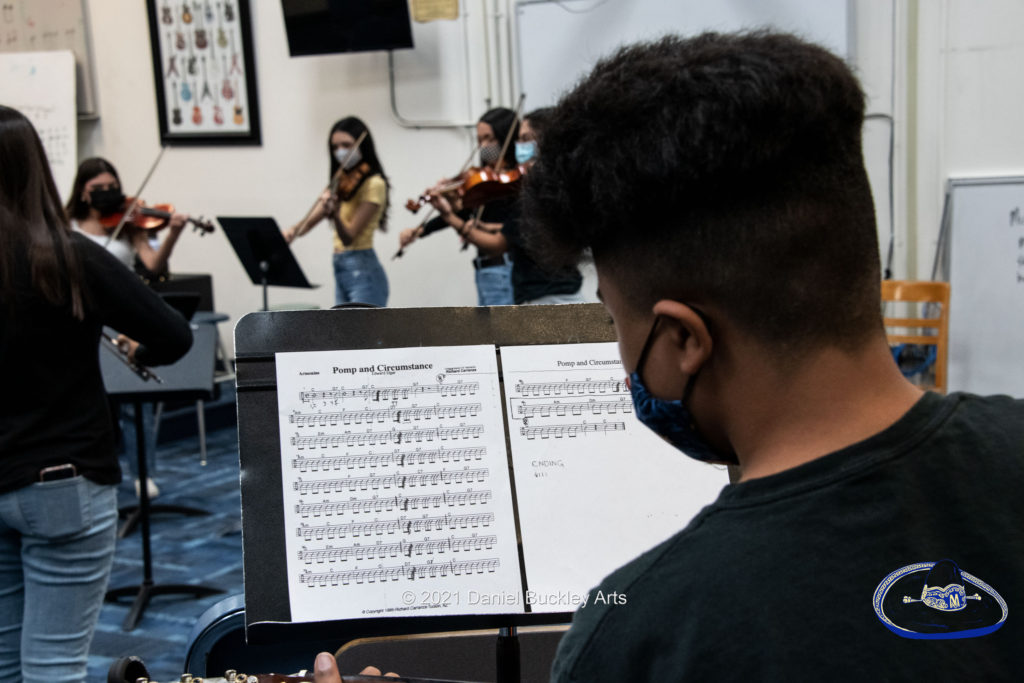It’s said that a picture is worth a thousand words.

This one represents almost as many stories.
On the surface it is a shot of Mariachi Aztlan de Pueblo High School in rehearsal.
The music on the stand is Sir Edward Elgar’s Pomp and Circumstance – the familiar march played at countless graduation events around the world.
The arrangement for mariachi is by Richard Carranza – the man who started Mariachi Aztlan in 1992 when he was a social studies teacher at Pueblo High.
Carranza grew up in that neighborhood. His dad hung sheet rock and his mom worked as a beautician. Both parents were fluently bilingual, but neither Richard nor his twin bother Reuben learned English until they attended Hollinger Elementary school where his teacher was Alfredo Valenzuela – Dr. V – he man who started the mariachi program at Davis Elementary. Their parents wanted them to always know who they are and to be able to speak with relatives still in Mexico. Later the brothers would join Tucson’s first youth mariachi – Mariachi Los Changuitos Feos (the Ugly Little Monkeys) founded in 1964 by an Irish Catholic priest named Charles Rourke. The group continues to this day, in secular hands since the 1970s.
Being part of Changos was huge. They were a community icon – a source of pride that toured the country and had great experiences. And by playing for four years with the group each member received a college scholarship. For Carranza’s parents that as a path forward for the boys.
But when they joined Changuitos the group was foundering, having trouble surviving, which put the scholarship in jeopardy. So Richard’s dad created a new group, appropriately called Mariachi Nuevo. The new group kept Changos high musical performance standards, raising things a notch by including the first female members of Tucson’s youth mariachi scene, culled from school orchestra programs. Excellent violinists had long been the Achilles heel of youth mariachis. Young Mexican American men in the ‘60s and ‘70s were not inclined to pick up the instrument.
But these young women were exceptional players who relished the opportunity to play more outside of the school orchestra. It didn’t take long (about six months) for Changos to bring in female recruits, and soon more youth mariachis started up, most with young men and women, despite the long tradition of mariachis being male-only.
Richard’s father suffered a health emergency and the group disbanded. But the members of that group went on, playing in whatever groups they could. It was what helped support the brothers as they attended college. Reuben became president of the Associated Students of the University of Arizona and went on to a career that included a vice presidency with Proctor & Gamble, and head of several beauty industry companies. And Richard landed a job as a social studies teacher at Pueblo.
You don’t make much as a teacher, so Richard supplemented his income playing with local mariachis. And one night a student spotted him and asked if he might teach him some guitar. When words spread several others joined them after school for guitar lessons. And not long after that the idea for a school mariachi started taking form in Richard Carranza’s head.
The timing was perfect. Egged on by the success of Linda Ronstadt’s Canciones de Mi Padre and Mas Canciones recordings and the huge student interest they generated, Tucson Unified School District Assistant Superintendent Becky Montaño was floating the idea of a curriculum-based mariachi musical program in the district. By the time Carranza got to Pueblo principal Dicky Gastellum to talk about the idea he’d already heard about Montaño’s idea.
Right place, right time. That’s the “miracle” part of The Mariachi Miracle. From the start of Los Chaguitos Feos by a jazz-loving Catholic priest who heard in mariachi music something as complex, rhythmically layered and culturally important as the jazz he loved to the board member (Joel Valdez)who floated the idea of a college scholarship program and the parent who might have a gig for one of the many groups that will put them over the top in their effort to buy new trades (the suit of Mexico’s gentlemen cowboys – the charros -word as the elegant uniform of the mariachi), someone was there. The right person for that moment.
Over the decades things snowballed through all sorts of random interactions until a national movement education evolved – one that would raise expectations of youth, propelling them toward college and good paying jobs, connecting them with family as well as historical and cultural roots. Creating a new, more expansive family that fans out across towns, states and a nation. A revolution punctuated not by gunfire but the shouting sound of trumpets, singers, and violins over the drumming rhythms of guitars, vihuela and guitarrones.
On that day in the early 1990s Richard Carranza was that miracle man, there at the right moment with all the skills and tenaciousness to make it happen. It was not easy. State educational standards had to be met, which meant teaches had to be accredited. And there was pushback, some of it blatantly racist. But every time a roadblock was put in place, Carranza and Juan De Dios Noperi tackled it. They created a curriculum, printed arrangements and more. They instilled discipline and pride in the students. And very quickly Mariachi Aztlan de Pueblo High School became a Tucson institutions.
There had been other school programs before – after school extra-curricular programs, mostly taught by accredited band and orchestra teachers, often augmented by actual mariachis from the community who were rarely compensated for their efforts. It was unfair. But this was important and they knew it. The state would not bend. The band and orchestra teachers became hooked, many throwing themselves into classes along with their students with the masters at the Tucson International Mariachi Conference, where the unpaid mariachis from their schools often taught huge numbers of students from around the country and Tucson, along with members of the renowned Mariachi Vargas de Tecalitlan, Mariachi Cobre and Los Camperos de Nati Cano.
TUSD’s commitment not just to creating musical programs that reflected and engaged the student body has blossomed over the years. A number of the students from the dramatic bloom of mariachi activity in the 1980s and 1990s came back to their schools as certified music and dance teachers and today lead programs in the schools they attended. Others started programs in schools in other cities and states around the country. And many became doctors, lawyers, architects, scientists, engineers, entrepreneurs, bankers, politicians and more. Empowered by experiences on their boards, mariachi parents found new possibilities in their communities as well. And the economic and political expectations of Tucson’s Mexican American community today is a far cry from what it was in 1964 when some of the first members of Mariachi Los Changuitos Feos became the first in their family to graduate high school and go on to college.
Carranza’s disgust with the racism and resistance faced in creating Mariachi Aztlan and the confidence he gained in beating the odds became the springboard to a career in educational administration. As assistant superintendent in Las Vegas he started mariachi programs that today keep thousands in school and snd them off to pursue their dreams fortified with the life skills to turn them into reality. He did the same when he became Superintendent of Schools in San Francisco a few years later, and built on such programs already in place in Houston when he was named superintendent there. From there he came to lead the largest school district on the planet as Chancellor of Education in New York City.
But I’m getting ahead.
The photo was taken at a very special rehearsal, one in which the members of Mariachi Aztlan were not only working on the music they would play a few weeks later at Pueblo’s graduation. They were also meeting and working with the new recruits who would replace the graduating seniors. They were mentoring these new recruits – some of whom were themselves about to graduate from middle school and start at Pueblo in the fall. This ritual of welcoming and making clear from day one that the expectation of graduation and a good life is at the core of this experience as much as the music is one of many instituted by Carranza.
From the masks worn it’s clear that this photo was taken during the waning days of the COVID-19 pandemic. But the photo also shows evidence of the movement’s evolution – both young men and women, skilled musicians, focused and working toward making graduation day something to remember for life for those moving on, and soon for themselves. Had the shot panned a little left you’d have seen calculus books and honors level text books of all sorts – evidence of the lofty educational expectations these performers meet, even as the excel at the trumpet, voice and stringed instruments.
The mariachi classroom and folklorico studios are incubators of success, change, opportunity and community involvement that race across the country at the speed of sound. This is a great untold American success story.
This is the heart of The Mariachi Miracle.

